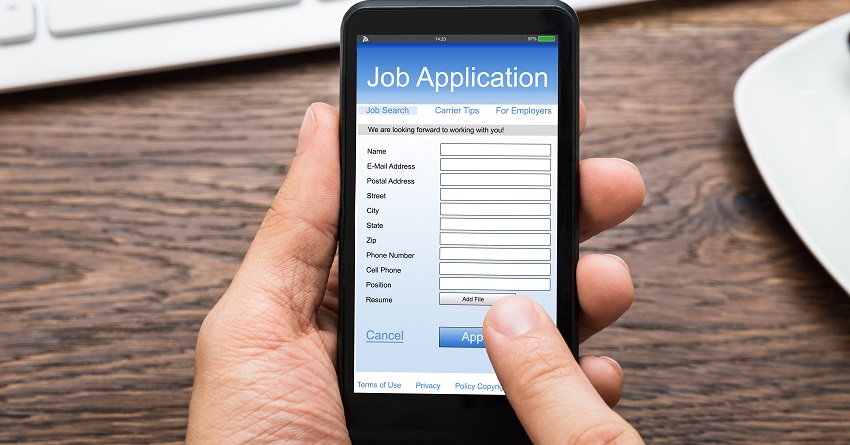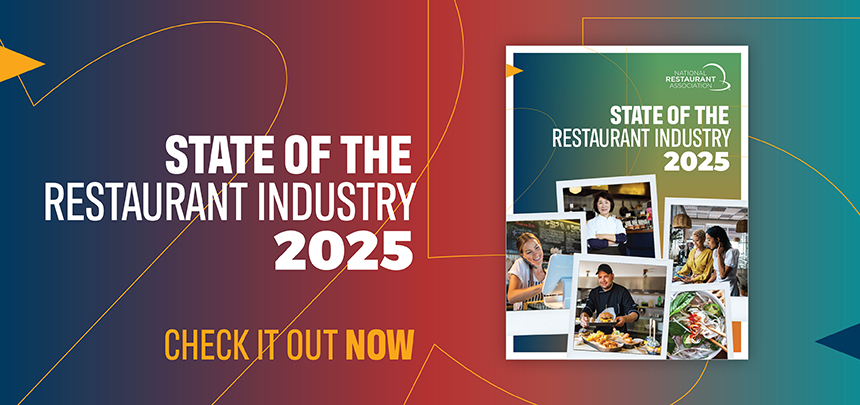Articles
February 27, 2024
High-tech tools for high-speed hiring
6 technologies that help restaurant operators speed up the recruiting process

Faced with a shallow labor pool, some operators are leveraging a variety of technologies to snag good candidates.
Nearly 9 in 10 restaurant operators reported that recruiting and retaining employees was a “significant” or “moderate” challenge in 2023, and most don’t see the situation getting much easier this year, according to the National Restaurant Association’s 2024 State of the Restaurant Industry report. In fact, 45% of operators said their restaurant doesn’t have enough employees to support existing customer demand.
Given the shallow labor pool, some restaurant operators are leveraging artificial intelligence and other technologies to help them snag good candidates. Here are six high-tech tools designed to provide a competitive edge in recruiting.
1. Applicant tracking systems (ATS) are software tools that help manage the recruiting process, from job posting to candidate screening to onboarding. They cut out time-consuming tasks—like sifting through applications and tracking candidates—allowing recruiters to focus on interviewing, assessing and hiring the best candidates. “Look for an ATS that’s tailored to what individuals searching for jobs in the foodservice industry want,” says Arlene Estrada Petokas, chief people officer of Kura Revolving Sushi Bar, including ease-of-use and multi-language capability.
While ATS platforms have been on the market for years, the latest versions are more sophisticated than ever, with some incorporating or integrating with the technologies listed below.
2. AI applicant assistants help restaurants engage with online and mobile job seekers 24/7 in a conversational text-based format—often communicating in multiple languages. Today’s AI assistants understand language nuances and can read between the lines. For example, given the question: Are you age 18 or over? an AI assistant might understand, “I am” or “I’m 21,” just as easily as a simple “Yes.” Some AI assistants can even learn your brand’s unique voice, incorporate popular slang and make occasional typos, to simulate a human conversation.
Facing a labor crunch during the “hot vax summer” of 2021, The Saxton Group, which operates 74 McAlister’s Deli locations in three states, switched to an ATS embedded with a conversational AI assistant that the group named Rachel. Potential applicants are greeted by a Rachel avatar, who conversationally asks for applicant information. There’s no need to create a user name or password. The focus is on the essentials, allowing job-seekers to quickly and easily complete the initial application. It previously took job seekers an average of 15 minutes to apply for a job at one of The Saxton Group’s McAlister’s Deli locations. Now, applicants complete the process in three minutes.
3. Automated interview scheduling moves candidates rapidly through the hiring funnel. Rachel, the Saxton Group’s AI assistant, asks applicants some basic information . . . “and then boom, they’re able to schedule an interview,” says vice president of People Matt Heston. Rachel offers available interview times, schedules the appointment, notifies the hiring manager, and sends a reminder to the applicant, decreasing the chance of no-shows. In the “old days,” the group’s hiring managers would log into an ATS, retrieve contact information for eligible candidates, reach out to them, and correspond back and forth to schedule a time. Now, all that is done automatically, saving the managers’ valuable time and securing the interview earlier—key in today’s competitive market. “Whoever gets to the candidates first, has a better chance of hiring them,” Heston notes.
Lehigh Valley Restaurant Group, which operates 20 Red Robin locations and 8 Wingstop locations in Eastern and Central Pennsylvania, decreased their time-to-hire by 80%, when they switched to an ATS with a conversational AI assistant and automated scheduling. “It's a huge time saver,” says Ann Jauregui, human resources generalist. “You're not having to sit in the office, away from your guests and away from your team, making phone calls and playing phone tag.”
4. Text/scan-to-apply functionality encourages job seekers to apply immediately to ads they happen upon while they’re out and about—most likely with their cell phone on hand. “We’re Hiring” signs are the perfect to place include a QR code or a “text-to” number that starts your application process. Multiunit operators can leverage geolocation capabilities to identify where applicants are located, so that they can connect them with job openings at nearby locations.
5. Video job descriptions showcase your brand dynamically, letting you share your restaurant’s story and forge a connection with job seekers. Some ATS platforms feature video capability, allowing applicants to hear about the job straight from crew members and to picture themselves as part of your team. Kura Revolving Sushi Bar is among the restaurants looking to incorporate videos. With a conveyor belt of Japanese specialties winding through each restaurant and drink-delivering robots scooting around, “we have a fun work environment, and we want to showcase it,” says Petokas, of Kura Sushi USA, which operates 58 U.S. locations, with nine more coming soon.
6. Programmatic job advertising uses software and data to optimize the placement of job ads. Rather than manually selecting which job boards to use, programmatic job advertising selects the boards for you based on your goals. The idea is to place your ad where it’s most likely to attract potential job seekers that are a good fit for your restaurant. Some programmatic job advertising platforms extend their reach beyond job sites and place ads on social media channels, apps, Google, and more to reach a larger pool of potential applicants.
Not sure which high-tech features you want? Consider scheduling product demonstrations with several different companies to see the features in action.
The National Restaurant Association’s 2024 State of the Restaurant Industry report is considered the authoritative source for restaurant industry sales projections and business trends. The report is free to members (a $349 value). Get the report today!
Given the shallow labor pool, some restaurant operators are leveraging artificial intelligence and other technologies to help them snag good candidates. Here are six high-tech tools designed to provide a competitive edge in recruiting.
1. Applicant tracking systems (ATS) are software tools that help manage the recruiting process, from job posting to candidate screening to onboarding. They cut out time-consuming tasks—like sifting through applications and tracking candidates—allowing recruiters to focus on interviewing, assessing and hiring the best candidates. “Look for an ATS that’s tailored to what individuals searching for jobs in the foodservice industry want,” says Arlene Estrada Petokas, chief people officer of Kura Revolving Sushi Bar, including ease-of-use and multi-language capability.
While ATS platforms have been on the market for years, the latest versions are more sophisticated than ever, with some incorporating or integrating with the technologies listed below.
2. AI applicant assistants help restaurants engage with online and mobile job seekers 24/7 in a conversational text-based format—often communicating in multiple languages. Today’s AI assistants understand language nuances and can read between the lines. For example, given the question: Are you age 18 or over? an AI assistant might understand, “I am” or “I’m 21,” just as easily as a simple “Yes.” Some AI assistants can even learn your brand’s unique voice, incorporate popular slang and make occasional typos, to simulate a human conversation.
Facing a labor crunch during the “hot vax summer” of 2021, The Saxton Group, which operates 74 McAlister’s Deli locations in three states, switched to an ATS embedded with a conversational AI assistant that the group named Rachel. Potential applicants are greeted by a Rachel avatar, who conversationally asks for applicant information. There’s no need to create a user name or password. The focus is on the essentials, allowing job-seekers to quickly and easily complete the initial application. It previously took job seekers an average of 15 minutes to apply for a job at one of The Saxton Group’s McAlister’s Deli locations. Now, applicants complete the process in three minutes.
3. Automated interview scheduling moves candidates rapidly through the hiring funnel. Rachel, the Saxton Group’s AI assistant, asks applicants some basic information . . . “and then boom, they’re able to schedule an interview,” says vice president of People Matt Heston. Rachel offers available interview times, schedules the appointment, notifies the hiring manager, and sends a reminder to the applicant, decreasing the chance of no-shows. In the “old days,” the group’s hiring managers would log into an ATS, retrieve contact information for eligible candidates, reach out to them, and correspond back and forth to schedule a time. Now, all that is done automatically, saving the managers’ valuable time and securing the interview earlier—key in today’s competitive market. “Whoever gets to the candidates first, has a better chance of hiring them,” Heston notes.
Lehigh Valley Restaurant Group, which operates 20 Red Robin locations and 8 Wingstop locations in Eastern and Central Pennsylvania, decreased their time-to-hire by 80%, when they switched to an ATS with a conversational AI assistant and automated scheduling. “It's a huge time saver,” says Ann Jauregui, human resources generalist. “You're not having to sit in the office, away from your guests and away from your team, making phone calls and playing phone tag.”
4. Text/scan-to-apply functionality encourages job seekers to apply immediately to ads they happen upon while they’re out and about—most likely with their cell phone on hand. “We’re Hiring” signs are the perfect to place include a QR code or a “text-to” number that starts your application process. Multiunit operators can leverage geolocation capabilities to identify where applicants are located, so that they can connect them with job openings at nearby locations.
5. Video job descriptions showcase your brand dynamically, letting you share your restaurant’s story and forge a connection with job seekers. Some ATS platforms feature video capability, allowing applicants to hear about the job straight from crew members and to picture themselves as part of your team. Kura Revolving Sushi Bar is among the restaurants looking to incorporate videos. With a conveyor belt of Japanese specialties winding through each restaurant and drink-delivering robots scooting around, “we have a fun work environment, and we want to showcase it,” says Petokas, of Kura Sushi USA, which operates 58 U.S. locations, with nine more coming soon.
6. Programmatic job advertising uses software and data to optimize the placement of job ads. Rather than manually selecting which job boards to use, programmatic job advertising selects the boards for you based on your goals. The idea is to place your ad where it’s most likely to attract potential job seekers that are a good fit for your restaurant. Some programmatic job advertising platforms extend their reach beyond job sites and place ads on social media channels, apps, Google, and more to reach a larger pool of potential applicants.
Not sure which high-tech features you want? Consider scheduling product demonstrations with several different companies to see the features in action.
The National Restaurant Association’s 2024 State of the Restaurant Industry report is considered the authoritative source for restaurant industry sales projections and business trends. The report is free to members (a $349 value). Get the report today!
Supported by
-
ParadoxParadox is the conversational recruiting software behind the world’s first Conversational ATS. Paradox is helping recruiters and hiring managers save hours every day on manual tasks by automating candidate screening, interview scheduling, and reminders, while delivering a world-class, frictionless and consumer-like mobile candidate experience.Learn more
We serve some of the industry's leading clients, including McDonald's, Darden, Whole Foods, Flynn, Focus Brands, Bloomin' Brands, Peet's Coffee, Taco Bell, Dunkin' and more.
Get the report
Get the report
Sign up for our Newsletter
The latest news from the National Restaurant Association, published every other Thursday
By clicking Submit I agree to receive email communications from the National Restaurant Association and agree to our Privacy Policy(Opens in a new window).

